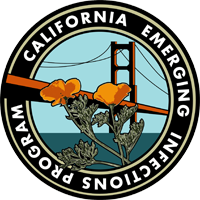
Overview
As part of the CDC’s Emerging Infections Program, CEIP conducts active, laboratory and population-based surveillance for all laboratory-confirmed COVID-19 hospitalizations among residents of Alameda, Contra Costa, and San Francisco counties. For each case, CEIP generates a case report form with basic demographic, SARS-CoV-2 testing, and admission information. Data are entered into a secure local database. De-identified case report data are transmitted weekly to CDC and included with data from other COVID-NET sites.
COVID-NET Purpose
SARS-CoV-2 (COVID-19)-Associated Hospitalization Surveillance Network (COVID-NET) is a population-based surveillance system that collects data on laboratory-confirmed COVID-19-associated hospitalizations among children and adults through a network of over 250 acute-care hospitals in 13 states participating in the Emerging Infections Program (EIP) and the Influenza Hospitalization Surveillance Project (IHSP). The purpose is to inform clinical and public health response and to estimate the national disease burden of COVID-19. https://www.cdc.gov/coronavirus/2019-ncov/covid-data/covid-net/purpose-methods.html
Surveillance Objectives:
Primary
- Estimate national COVID-19-associated hospitalization rates in all ages in a timely manner (e.g., weekly,).
- Estimate COVID-19-associated intensive care unit (ICU) hospitalization rates and in-hospital mortality rates in all ages.
Secondary
- Describe the characteristics, clinical features, and clinical course (e.g., severe illness and associated complications) of persons hospitalized with COVID-19.
- Estimate rates of laboratory-confirmed COVID-19 hospitalizations by vaccination status
- Assess risk factors for COVID-19-associated complications among hospitalized cases.
Case Finding
Case ascertainment utilizes reports from hospital laboratories, admission/discharge information, infection control practitioner logs/databases, and review of the California Department of Public Health (CDPH) reportable diseases database, California Reportable Disease Information Exchange (CalREDIE), to identify hospitalized COVID-19 cases in catchment area residents. All cases are logged into a database, and de-identified data are transmitted weekly to CDC.
Case Definition
A case is defined by laboratory confirmed SARS-CoV-2 in a person who:
- Lives in the 3-county COVID-NET surveillance area AND
- Tests positive for SARS-CoV-2 within 14 days before or during hospitalization.
Evidence of COVID-19 infection can be obtained through several laboratory tests:
- Molecular assays, such as reverse transcription polymerase chain reaction (RT-PCR)
- Commercially available rapid antigen detection tests
- Serology (antibody) tests (must be paired acute and convalescent specimens)
Active Surveillance
CEIP Surveillance Officers complete a standardized case report form (CRF) for a subset of cases hospitalized in the previous month, following CDC’s sampling guidance, to inform clinical and public health response. Data sources include laboratory records, CalREDIE, and medical chart reviews. Information collected on the CRFs includes:
- Demographic information
- Admission information (i.e., hospital and date of admission, reason for admission)
- Discharge information (i.e., discharge date, discharge diagnoses, outcome)
- Type of residence prior to admission
- Pre-existing medical conditions
- COVID-19 vaccination status
- Pregnancy status (for females aged 15-49)
- Symptoms present on admission
- Clinical course (i.e., imaging and lab test results, medical interventions, ICU status)
Geocoding and Linkage to Census Data
Case address at time of admission is geocoded for a sample of cases using standard software to determine the census tract of residence. The census tract is linked to US Census data to obtain socioeconomic indicators associated with the census tract. These data can be used to find associations between geographic location, socioeconomic indicators, and risk for hospitalization with COVID-19.
Current Projects
- Death Ascertainment
Surveillance data are linked to state vital death data to determine whether a case-patient has died during hospitalization or within 60 days after discharge date. - Vaccination Status at Time of Admission
Surveillance data are linked to state vaccination registry data to determine vaccination status at the time of hospital admission, including vaccine dates, and type of COVID-19 vaccination given. - Genetic Sequencing
This project aims to evaluate epidemiologic differences of SARS-CoV-2 variants identified from COVID-NET patients. Objectives: - Determine the feasibility of obtaining sequencing data as it is available and/or identifying and sequencing residual clinical specimens from hospitalized patients identified as COVID-NET cases.
- Identify genetic groups of SARS-CoV-2 viruses collected from COVID-NET hospitalized cases.
- Link sequencing data to clinical and epidemiologic data collected through COVID-NET.
- Describe and compare demographics, clinical characteristics, and vaccination status of hospitalized patients infected with different genetic variants of SARS-CoV-2.
- Evaluate and compare the severity of disease and outcomes of patients infected with different genetic variants of SARS-CoV-2.
COVID-NET Summarized Data
COVID-19-associated hospitalization rates are reported to CDC on a weekly basis. COVID-NET data, including hospitalization rates for different age groups and data on patient characteristics, are available on COVIDView: https://covid.cdc.gov/covid-data-tracker/#datatracker-home
Publications
Publications containing important public health findings derived from the surveillance data collected by the CEIP and the national COVID-Net sites can be found at the following link (bottom of webpage):
https://www.cdc.gov/coronavirus/2019-ncov/covid-data/covid-net/purpose-methods.html
Contact
For questions about COVID-19 surveillance and projects, please contact:
Pam Daily Kirley, MPH
California Emerging Infections Program
Viral Respiratory Diseases Project Manager
respnet@ceip.us
Information and Guidance for the Public:
Centers for Disease Control and Prevention (CDC) COVID-19:
Coronavirus Disease 2019 (COVID-19) | CDC
https://covid.cdc.gov/covid-data-tracker/#datatracker-home
California Department of Public Health COVID-19:
https://covid19.ca.gov/state-dashboard/
